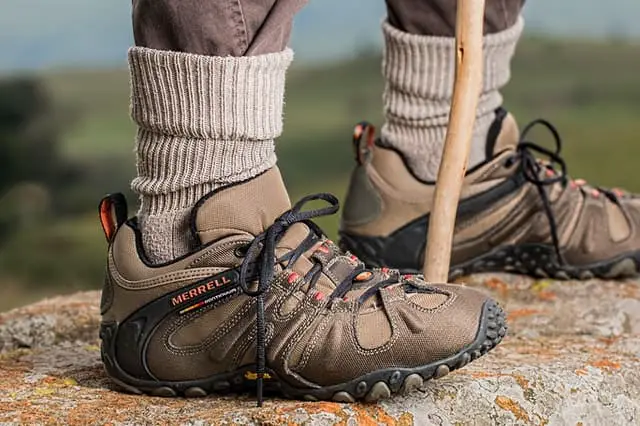Are you confused between Gore-Tex and non-Gore Tex Boots? Do you want to know whether Gore-Tex is something that you actually need for hiking?
Both types of boots have some distinct features and unique benefits that are important to remember when choosing the best option for your hiking needs.
Which is the better option for hiking, Gore-Tex or non Gore-Tex boots?
For areas where the terrain may have standing water, Gore-Tex boots provide better protection against water and will keep your feet dry and cool. Other hiking boots that aren’t made with Gore-Tex are more breathable and the best option in dry and warm environments.
As you can see there are a few key differences between the two types of boots, so let’s take a closer look to help you make the right decision.
Gore-Tex & Non Gore-Tex Comparison
| Gore-Tex | Non Gore-Tex | |
| Waterproof | Yes | Depends |
| Features | Insulated, Breathable, Windproof | Durable, Water-resistant, Lightweight |
Since we’re comparing very specific technology in Gore-Tex to all of the other boots on the market it can be tough to fully grasp. The best way is to consider the following Gore-Tex features and see if they would be useful for your adventures.
- Waterproof
- Water Resistant
- Rugged
- Insulated for cold weather
- Lightweight
- Comfortable
An Overview of Gore-Tex Boots
The main advantage of wearing Gore-Tex boots is their ability to stay dry even when walking through puddles or rain. Each boot comes with an outside layer that works to prevent any moisture or water from getting inside.
As well as being waterproof, these boots are optimized for more breathability. Some hikers might not think it’s that important, but there’s nothing worse than having your feet get wet and stay wet. With the Gore-Tex technology, it’s much easier for moisture to escape and for you to stay cool, comfortable, and dry no matter the conditions.
Because of the insulation built into these shoes and boots, they’re often a great option for winter hiking or cold weather adventures. The inside layer will keep your feet warmer for much longer, even as the temperatures start to drop.
Gore-Tex vs Non Gore-Tex Boots
- Rainy Conditions – Gore-Tex boots are a better option for cold and rainy conditions. If you’re hiking in moisture-prone areas, you should consider using Gore-Tex boots.
- Warm Conditions – Non-Gore Tex boots are a good choice for warm conditions where you don’t need the increased insulation. The Gore-Tex boots are insulated and could become too warm and cause sweating in warm weather.
- Winter Hiking – Gore-Tex boots are often preferred for hiking in snowy areas. The boots will keep you dry and warm even when walking in the snow. Non Gore-Tex boots that aren’t water resistant might not be a good choice for hiking in the snow.
- Standing Water – Any terrain with lots of standing water and mud will demand Gore-Tex boots. If you wear waterproof shoes, the water and moisture in the grass will not penetrate inside. For extremely wet conditions like river crossing, avoid Gore-Tex boots because water that gets inside the boot would take longer to dry out.
- Dry Conditions – Non Gore-Tex boots can be the right choice for dry conditions. Even if the condition is cold, you should go with non-waterproof shoes to keep your feet warm.
What Makes Gore Tex Boots Worth Buying?
The key benefit of waterproof boots is that they will protect your feet from moisture and water. Any outside water should be prevented from soaking inside.
This is important for people who hike where there are wet conditions since you want to stay comfortable on the trail. They will keep your feet warm in cold conditions and can prevent chafing and blisters.
When Should You Avoid Gore Tex Boots?
It is worth mentioning that moisture cannot easily get out of your Gore-Tex boots. Your feet will remain wet throughout your hiking.
Therefore, you should avoid them in dry and warm conditions. The sweat can cause moisture and discomfort around your feet.
Conclusion
From the above, it is clear that both Gore-Tex and non Gore-Tex boots are great hiking boots. However, you will have to choose the right boot depending on your hiking condition.
For example, if you want to explore a warm and dry area, you can wear non Gore-Tex boots. If it’s a rainy area you’ll be visiting, you should consider going with Gore-Tex boots!



